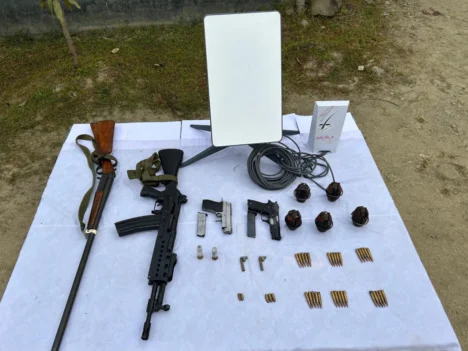First, President Droupadi Murmu flew a Sukhoi 30 fighter jet from the Tezpur air base in India’s northeastern state of Assam on April 8.
Two days after the maiden sortie of the Supreme Commander of the Indian Armed Forces from a base close to the Sino-Indian border, Union Home Minister Amit Shah visited the country’s easternmost frontier and sent a strong message to Beijing against its expansionist move.
The fact that both the developments took place days after China’s move to rename villages in India’s Arunachal Pradesh clearly indicates that neither the President’s 30-minute sortie on the sky along the Sino-Indian border nor Shah’s visit to Kibithoo is not any coincidence but well-orchestrated moves to counter the neighbouring country in their own coin.
Standing at Kibithoo, just 15 km south of the Line of Actual Control (LAC) between India and China, Shah not only reiterated the government’s commitment to protecting the territorial integrity of India but also affirmed that gone are the days when one could think of encroaching upon India’s land.
“Our policy is clear. We want peace from everybody. But no one can encroach on even an inch of our territory. The protection of borders is the protection of the country, which is why Prime Minister (Narendra) Modi has made border infrastructure a matter of priority,” Shah said while addressing a rally at Kibithoo.
Shah’s visit to Kibithoo has already drawn a sharp reaction from the Chinese government as the country’s foreign ministry termed the visit to the ‘Chinese territory’ a violation of Beijing’s territorial sovereignty by Indian officials.
Shah, on Monday, launched the ‘Vibrant Villages Programme’ (VVP) in Arunachal Pradesh’s Kibithoo in Anjaw district, which shares borders with China and Myanmar, to boost road connectivity. The programme also envisages providing tap water, electricity, cooking gas, financial inclusion, and digital and physical connectivity in the remote border areas.
According to government statistics, the programme would positively impact 2,967 villages in 46 blocks of 19 districts along the northern border in Arunachal Pradesh, Sikkim, Uttarakhand, Himachal Pradesh and Ladakh. In the first phase of the project alone, 1.42 lakh people in 662 villages will benefit.
Renewed focus on border infrastructure
It may be mentioned here that defence preparedness, particularly in the eastern sector, has got a renewed focus since the BJP-led National Democratic Alliance government came to power at the centre in 2014.
While the government has affected a reorientation of the troops’ deployment in the strategically sensitive eastern frontier of the country, the region has also seen projects to boost connectivity, particularly to the remotest areas in the northeast in the last few years.
While roads are being built to the most outlying locations in the northeastern states, including in Arunachal Pradesh, which borders China and Myanmar, the Indian Army is also building several military infrastructures, including bridges, ammunition depots, tunnels, helipads and bolstering monitoring systems to add to the combat readiness of the Indian Army.
While the much-hyped Arunachal Frontier Highway, one of the country’s most significant road projects, is being built, works are also on for the Trans-Arunachal Highway and the East-West Industrial Corridor Highway which will ensure last-mile connectivity to all the border areas in the hilly state.
The 2000 km long Arunachal Frontier Highway will start at Mago, adjacent to Bhutan, and pass through Tawang, Upper Subansiri, Tuting, Mechuka, Upper Siang, Debang Valley, Desali, Chaglagam, Kibithu, Dong, before ending at Vijayanagar near the Myanmar border.
To be built at an estimated cost of Rs. 40,000 crores, the Arunachal Frontier Highway will be a big boost for the Indian Army as it will ensure fast movement of troops and machinery as and when needed. One can assume the importance of the Arunachal Frontier Highway by the fact that the project was objected to by China when it got the nod from the Indian Prime Minister’s Office in 2014.
The weapon system in Arunachal Pradesh
It may be mentioned here that the Indian Air Force 2016 landed its fighter plane Sukhoi 30 at the Advanced Landing Ground (ALG) at Pasighat in Arunachal Pradesh, which shares an international boundary with China. The IAF had also taken steps to upgrade and make the advanced landing grounds operational at forward areas like Walong, Ziro, Along, Mechuka, Pasighat, Tuting, Vijayanagar and Tawang.
The sources in the defence ministry had also informed that apart from the operationalisation of the ALGs in Arunachal Pradesh, steps are being taken to connect most of the forward posts along the LAC in Arunachal Pradesh with a large helipad for swift mobilisation of troops and military equipment.
There are also efforts to link all the forward posts in Arunachal Pradesh with the optical fibre network and to have separate satellite terminals for bolstering overall surveillance and communication.
Sources in the Army further said that the Army has also deployed many indigenously built remotely piloted aircraft in the forward posts in Arunachal Pradesh and deployed all-terrain vehicles, 7.62MM Negev Light Machine Guns from Israel, and various other lethal weapons.
In 2019, the artillery firepower of the Indian Army along the eastern frontier got a boost when the M777 Ultra-Light Howitzers were deployed along the forward positions along the LAC in Arunachal Pradesh.
The US Army has used the M777s in Afghanistan and Iraq, and it has also been used by the ground forces of Australia, Canada, India and Saudi Arabia. It made its combat debut in the War in Afghanistan.







